(By C. Tienrey, 2010)
Lava domes, which may also be referred to as volcanic domes, are common features in volcanic regions throughout the world. Lava domes can come in many shapes and sizes, and while they may not be quite as spectacular as their explosive or flowing counterparts, they are often still an awe inspiring sight to see. The purpose of this page is to provide a brief introduction to lava domes, which will by no means be entirely comprehensive. In fact, even today, there is still much unknown about lava domes and what they can potentially reveal about volcanic systems.
Lava domes are formed by viscous magma being erupted effusively onto the surface and then piling up around the vent. Like lava flows, they typically do not have enough gas or pressure to erupt explosively, although they may sometimes be preceded or followed by explosive activity. However, unlike lava flows, the lava that forms domes is often to thick and sticky to flow very far, and thus instead pile up thick and high around the vent.
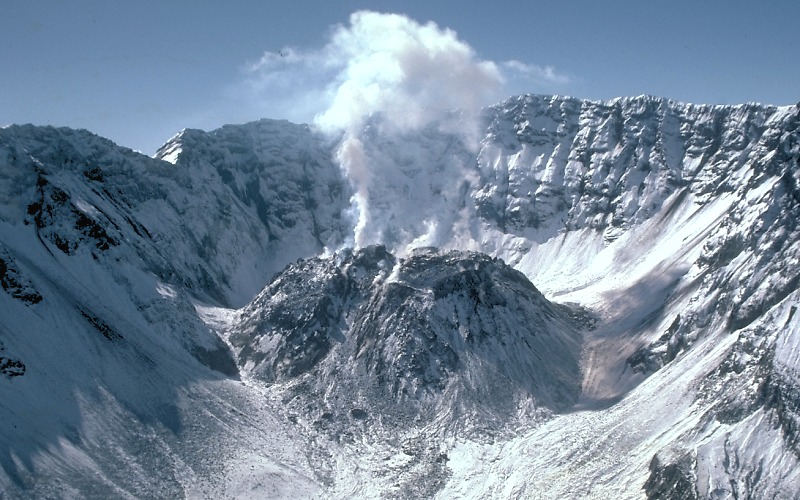
USGS picture of the growing Mount St. Helens Lava dome. This lava dome started developing shortly after the iconic May, 18th 1980 eruption and dome growth continued until 1986. Photo credit: USGS. 1984
2009 picture of Chillahuita lava dome found in the Andes Mountains of South America. Note the large difference in appearance (and size!) as compared to the 1980’s Mount St. Helens Lava dome.Photo credit: Casey Tierney.
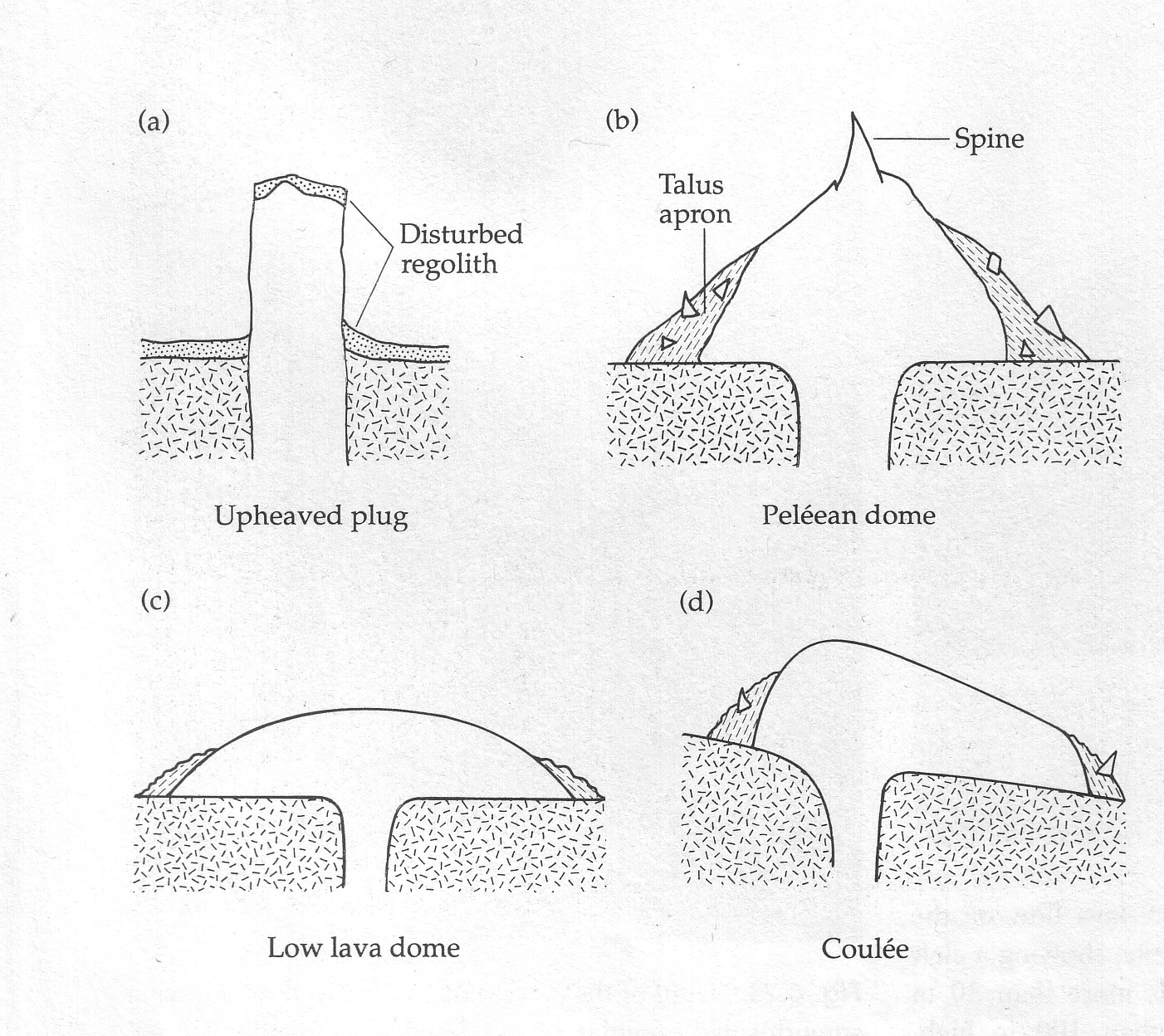
There is no shortage of variety when it comes to lava domes.
Lava domes can be divided based on their shape, texture and eruptive style. For the purposes of this overview we have chosen to stick with the Blake (1999) classification of lava domes, based primarily on morphology. See figure left.
The four major types are Low Lava Dome (or Torta), peléean, coulées, and upheaved Plug. Click the drop down menu below to learn more about the different types of domes.
Named after their striking resemblance to cake or “Torta”, these domes are common throughout the world, but especially so in the Andes mountains of South America. This type of lava dome is generally erupted on mostly flat ground and as a result the lava is able to push outwards, but not far. They typically are flat-topped and roughly circular. The thickness and diameter of these domes can vary greatly from a few meters to nearly a kilometer in thickness and several kilometers in diameter. These domes grow by internal processes and lava fills in the center of the dome near the vent and pushes older layers outwards, forming an onion-like internal structure.
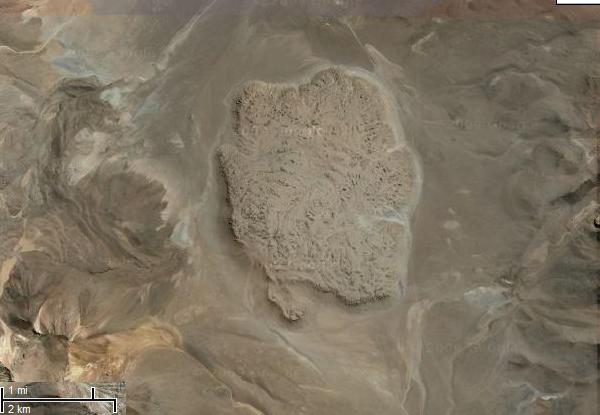
Photo credits: Casey Tierney (Left) and Google Maps (Right).
Chillahuita is an excellent example of a torta. Note the steep sides and the flat top.
Named after the iconic lava dome formed on Mt. Pelee in 1902 (which eventually collapsed resulting in the destruction of St. Pierre on Martinique), these lava domes are often the steepest sided of all lava domes. They are typically circular similar to Tortas, but rather than having a flat top, they show relatively smooth upper surfaces punctuated by tall vertical spines. These vertical spines give these domes a craggy appearance and also frequently collapse causing talus slopes to frequently surround these domes. This type of dome is most commonly found associated with larger composite volcanoes.
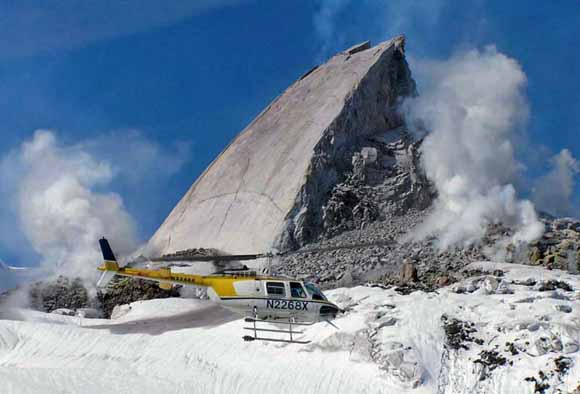
The large spine growing out of the 2004-2006 Mount St. Helens lava dome makes it an example of a Peléean lava dome.
Photo credit: USGS.
Coulées are a hybrid between a lava dome and a lava flow. In order to get the thick and sticky lava to flow, this type of dome is generally erupted on steep slopes which allow the lava to ooze slowly down the slope. Typically they do not flow more than a few kilometers, though some larger examples have traveled well over 10km. As a neat feature of coulées, huge pressure ridges, known as Ogives, are often seen on the outer surface of the flow.
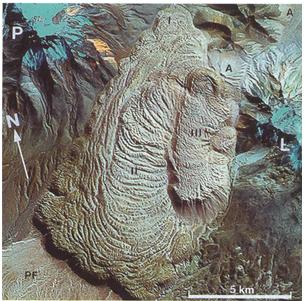
Chao, located in the Andes, is an excellent example of a coulée. It was erupted on a very steep slope which allowed it to flow for nearly 14km downslope. The flow front is over 700m high. Note the distinct Ogives on the surface.
Photo credit: Shan de Silva.
Upheaved Plugs are a rare and interesting type of lava dome. The erupting lava has a higher yield strength (thus is stronger) than the lavas that form other domes, and as a result this lava is pushed up like a piston. These piston like extrusions often travel high above the surface and sometimes carry country rock sediment along with them.

Shinzan dome in Japan. Masao Momatsu recorded the stages of growth by drawing on his window overlooking the dome.
Photo from Francis, P., Oppenheimer, C. 2004.
Related to lava domes is a volcanic feature known as a cryptodome. A cryptodome occurs when magma is brought very near the surface but does not breach to the surface. This shallow intrusion of magma forms a bulge on the surface, closely resembling a lava dome.
Thanks to open access publication, you can see a great example of cryptodome formation and morphology at the Usu volcano in Hokkaido, Japan!
As you may have seen above, lava domes have numerous morphological features. A bit more detail on the 'how' of lava dome morphology and their products can be found by clicking the buttons to the right.
A bit of information on the dangers and products of domes are hosted in the menu bar above.
References and Additional Resources
USGS website on lava domes. http://vulcan.wr.usgs.gov/Glossary/Domes/description_lava_dome.html
Francis, P., Oppenheimer, C. 2004. Volcanoes. 2nd Ed. Oxford University Press, New York.
Fink J. H., Anderson, S.W. 2000. Lava domes and Coulees, In: Sigurdsson et al., eds., Encyclopedia of Volcanoes, Academic Press, 307-319.
Blake, S., 1989, Viscoplastic models of lava domes, IAVCEI Proceddings in Volcanology, Vol.2. Lava flowsand domes, Springer Verlag, Heidelberg, 88-126.
de Silva, S.L., Self, S., Francis, P.W., Drake, R.E., Ramirez, C., 1994. Effusive silicic volcanism in the Central Andes: The Chao dacite and other young lavas of the Altiplano-Puna Volcanic Complex. Journal of Geophysical Research, 99, 17,805-17,825.
Francis, P., Oppenheimer, C. 2004. Volcanoes. 2nd Ed. Oxford University Press, New York.
Fink J. H., Anderson, S.W. 2000. Lava domes and Coulees, In: Sigurdsson et al., eds., Encyclopedia of Volcanoes, Academic Press, 307-319.
Blake, S., 1989, Viscoplastic models of lava domes, IAVCEI Proceddings in Volcanology, Vol.2. Lava flowsand domes, Springer Verlag, Heidelberg, 88-126.
de Silva, S.L., Self, S., Francis, P.W., Drake, R.E., Ramirez, C., 1994. Effusive silicic volcanism in the Central Andes: The Chao dacite and other young lavas of the Altiplano-Puna Volcanic Complex. Journal of Geophysical Research, 99, 17,805-17,825.